What Do Swallowtail Butterfly Eggs Look Like to Be Unique?
Swallowtail butterfly eggs are small, spherical, and measure between 1 to 2 millimeters in diameter. They exhibit a smooth surface texture and come in various colors, including pale green, yellow, and white, which provide effective camouflage against foliage.
Occasionally, rarer colors such as pink or red may appear due to genetic variations. The eggs are usually laid singly on the underside of host plant leaves, such as parsley, fennel, and milkweed, maximizing larval survival.
Observing these features can greatly aid in identifying swallowtail eggs and understanding their ecological adaptations further.
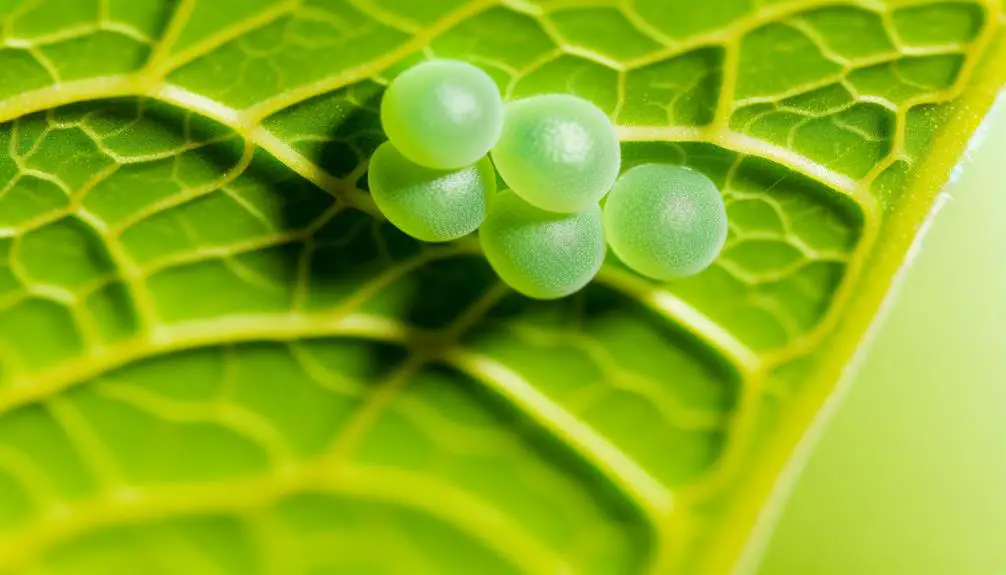
Key Takeaways
- Swallowtail butterfly eggs are small, measuring 1-2 millimeters in diameter.
- They are spherical in shape with a smooth surface.
- Egg colors range from pale yellow and bright green to translucent white and light brown.
- Eggs are typically laid singly on the underside of host plant leaves.
Egg Size
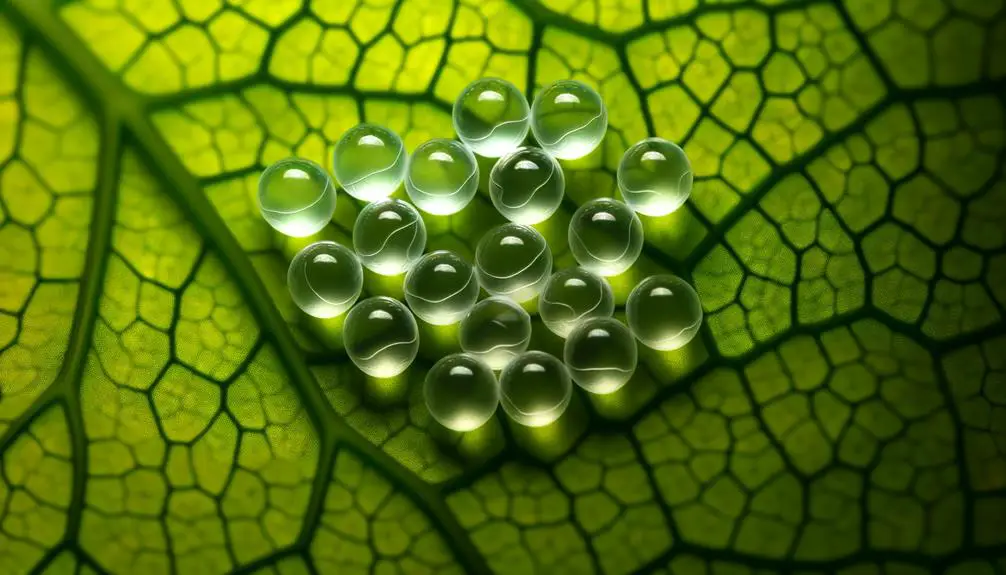
Swallowtail butterfly eggs typically measure between 1.0 to 1.5 millimeters in diameter, a size that is consistent across most species within the Papilionidae family. This diminutive size guarantees minimal visibility to predators, providing a degree of protection vital for embryonic development.
The eggs are generally spherical, exhibiting a smooth surface that aids in adherence to host plants. The precise measurement of these eggs allows for accurate identification and study, facilitating research that can lead to enhanced conservation efforts.
Understanding the egg size is fundamental for entomologists and hobbyists alike, as it informs breeding programs and ecological impact assessments. Each minute egg holds the potential for transformation, embodying the intricate life cycle of these enchanting insects.
Color Variations
Swallowtail butterfly eggs exhibit a range of color variations that can be indicative of species and environmental factors.
Commonly, these eggs present hues of pale green, yellow, or white, providing camouflage against foliage.
However, unusual color variations such as pink or red have also been documented, suggesting potential adaptive responses to specific ecological pressures or genetic differences.
Common Color Patterns
Exhibiting a range of hues from pale yellow to vibrant green, the eggs of swallowtail butterflies demonstrate significant color variations based on species and environmental factors.
These common color patterns serve vital roles in camouflage and survival. The following are some typical color characteristics:
- Pale Yellow: Often seen in early developmental stages, blending with host plant foliage.
- Bright Green: Common in later stages, aiding in camouflage against green leaves.
- Translucent White: Seen in certain species, allowing for light penetration and aiding in temperature regulation.
- Light Brown: Found in species that lay eggs on woody or dry substrates, providing a protective disguise.
These variations are essential for evading predators and ensuring successful development through the larval stage.
Unusual Color Variations
In addition to the common color patterns, swallowtail butterfly eggs occasionally exhibit unusual coloration such as deep red or metallic blue, which may result from genetic mutations or unique environmental pressures.
These rare pigments can be attributed to variations in the deposition of carotenoids and other pigments during egg formation.
Environmental factors, such as the presence of specific minerals in the soil, can also influence these color variations.
Furthermore, such atypical hues may provide adaptive advantages by increasing the eggs' camouflage against predators in certain habitats.
The study of these unusual colorations offers valuable insights into the genetic diversity and adaptive strategies of swallowtail butterflies, contributing to our broader understanding of evolutionary biology and species survival mechanisms.
Shape and Form
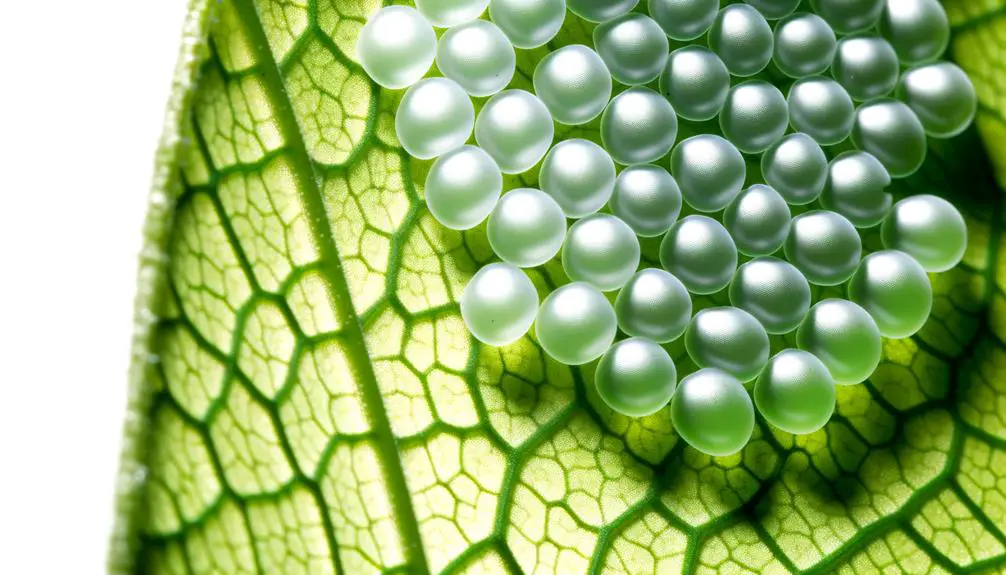
Characterized by their spherical shape and smooth surface, swallowtail butterfly eggs exhibit a remarkable uniformity in form that aids in their identification and study. These eggs are typically minuscule, ranging in size from 1 to 2 millimeters in diameter, making them almost perfectly round. The spherical geometry of the eggs minimizes surface area, which can be advantageous for structural integrity and moisture retention. This uniformity assists researchers in distinguishing swallowtail eggs from those of other species.
Significantly, four important aspects of their shape and form include:
- Spherical Geometry: Almost perfectly round.
- Size: Generally 1-2 millimeters in diameter.
- Symmetry: Exhibits high degree of regularity.
- Durability: Structural integrity supports embryonic development.
Understanding these attributes is essential for accurate identification and ecological studies.
Surface Texture
The surface texture of swallowtail butterfly eggs exhibits notable variability, ranging from smooth to bumpy exteriors.
These eggs also display a spectrum of color variations, which can serve as camouflage or signaling mechanisms.
Under microscopic examination, intricate surface details become evident, providing insights into their structural adaptations and potential protective functions.
Smooth or Bumpy Exterior
Examining the surface texture of swallowtail butterfly eggs reveals a fascinating variation between smooth and bumpy exteriors, each serving specific ecological and developmental purposes.
The smooth texture often facilitates the eggs' attachment to specific host plants, aiding in camouflage and protection from predators. Conversely, bumpy exteriors can enhance adhesion and deter parasitic wasps.
The following points highlight the significance of these textures:
- Attachment: Smooth exteriors help eggs stick more securely to host plants.
- Camouflage: Smooth surfaces can blend better into the plant environment.
- Deterrence: Bumpy textures can make eggs less accessible to predators.
- Adhesion Enhancement: Bumps increase surface area, improving egg stability.
These variations underscore the adaptive strategies swallowtail butterflies employ to guarantee the survival of their offspring.
Color Variations Observed
While the texture of swallowtail butterfly eggs plays an essential role in their survival, their color variations also contribute considerably to their ecological adaptability and protection against predators. Swallowtail butterfly eggs exhibit a range of hues from pale yellow to vibrant green, often influenced by the plant surfaces they are laid upon to enhance camouflage. These color variations not only help in blending with the foliage but also in signaling different developmental stages to conspecifics.
| Color | Frequency | Adaptive Significance |
|---|---|---|
| Pale Yellow | Common | Initial camouflage on bright foliage |
| Light Green | Frequent | Blends with young leaves |
| Deep Green | Less Frequent | Matches mature leaves |
| Reddish Brown | Rare | Mimics decaying plant material |
This color diversity guarantees higher survival rates by minimizing predation risks.
Microscopic Surface Details
Beyond the adaptive color variations, the microscopic surface details of swallowtail butterfly eggs exhibit intricate textures that play a significant role in their protection and development.
These surface textures are characterized by:
- Fine Ridges: These ridges increase the structural integrity of the egg, preventing physical damage.
- Micropores: Facilitating gas exchange, micropores guarantee the developing embryo receives adequate oxygen.
- Microvilli: Small hair-like projections that deter microbial invasion, protecting the embryo from potential pathogens.
- Surface Crystals: These create a rough exterior that can camouflage the egg against predators and environmental elements.
Such detailed surface structures are not merely decorative but crucial for the egg's survival, showcasing an evolutionary adaptation finely tuned for the butterfly's reproductive success.
Egg Placement
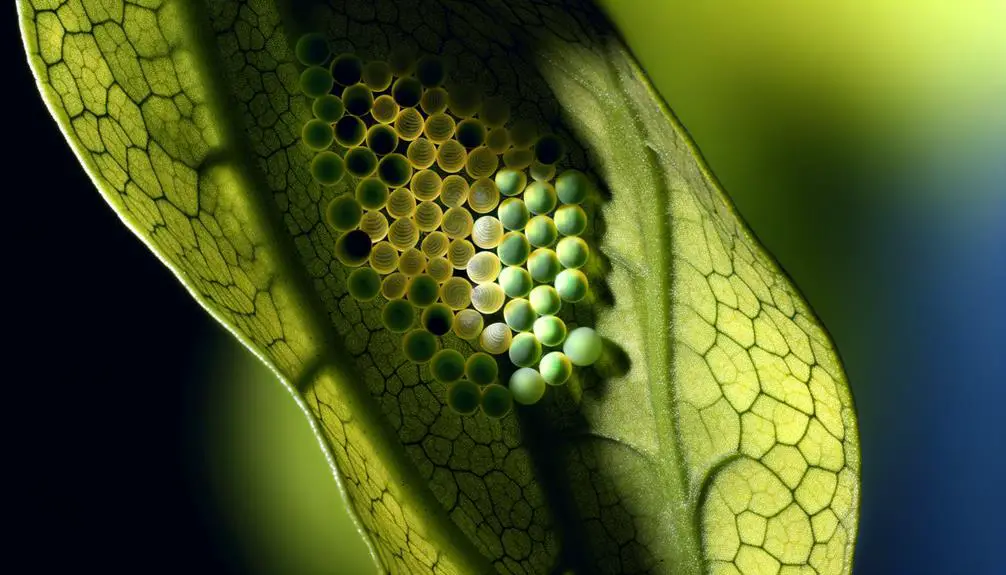
Strategically positioning their eggs, swallowtail butterflies typically select host plants that maximize the survival chances of their larvae. The choice of placement is influenced by factors such as leaf surface, plant height, and proximity to predators. By meticulously analyzing these factors, female swallowtails enhance the likelihood of larval growth and development. Eggs are usually laid on the underside of leaves, reducing exposure to potential threats and environmental hazards.
Here is a concise table summarizing key egg placement factors:
| Factor | Importance | Description |
|---|---|---|
| Leaf Surface | High | Offers camouflage and protection |
| Plant Height | Moderate | Balances accessibility and predator risk |
| Proximity to Predators | Critical | Directly impacts larval survival |
| Environmental Conditions | Variable | Influences egg viability |
This strategic placement is crucial for the continuation of the swallowtail lifecycle.
Host Plants
The selection of host plants is a critical factor influencing the survival and development of swallowtail butterfly larvae, directly tied to the strategic egg placement practices of the female butterflies.
Swallowtail butterflies exhibit remarkable specificity in choosing host plants, ensuring ideal conditions for their progeny. These host plants provide essential nutrients and protection against predators.
Key characteristics of perfect host plants for swallowtail butterflies include:
- Nutritional Content: High concentrations of essential nutrients cater to larval growth.
- Chemical Defenses: Presence of compounds that deter predators, benefiting the larvae.
- Surface Texture: Suitable leaf surfaces for egg adhesion and larval mobility.
- Availability: Abundance and accessibility of the plant within the butterfly's habitat range.
This meticulous selection underpins the ecological success of swallowtail butterflies.
Egg Clusters
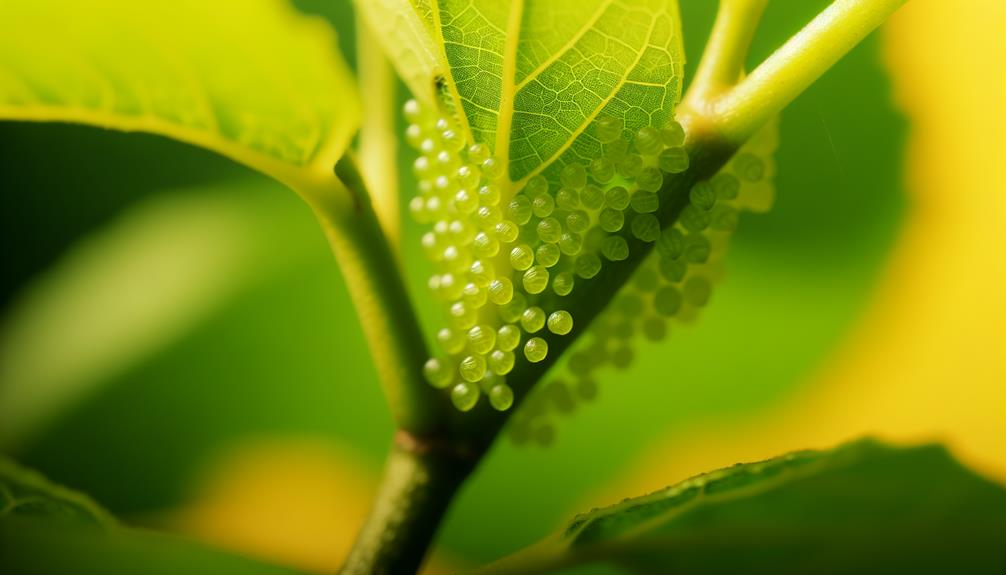
Intriguingly, the formation of egg clusters by swallowtail butterflies plays a pivotal role in optimizing the survival rates of their offspring. Typically, swallowtail females deposit their eggs in small groups on the underside of host plant leaves. This strategic clustering confers several advantages.
To begin with, it enhances the likelihood that at least some larvae will evade predators and adverse environmental conditions. In addition, the clustered eggs can benefit from microclimatic conditions, such as humidity and temperature, that are more stable than those experienced by solitary eggs.
Furthermore, clustering may facilitate synchronized hatching, ensuring that larvae can collectively exploit the available resources. This cooperative emergence reduces the individual vulnerability to predators and maximizes the chances of reaching maturity.
Development Stages
Following the advantageous formation of egg clusters, swallowtail butterfly eggs undergo a series of meticulously orchestrated development stages, each critical for the successful metamorphosis from egg to larva.
Initially, embryogenesis occurs, involving cell division and differentiation within the egg. This is followed by the formation of the larval structures, preparing the embryo for hatching.
The key development stages include:
- Cleavage: Rapid cell division without growth, creating a multicellular embryo.
- Gastrulation: Cells rearrange to form three primary germ layers—ectoderm, mesoderm, and endoderm.
- Organogenesis: Development of organs and tissues from the germ layers.
- Hatching: The larva, equipped for its new environment, emerges from the egg.
Each stage is essential for the precise transformation from a single cell to a complex larval form.
Identifying Swallowtail Eggs
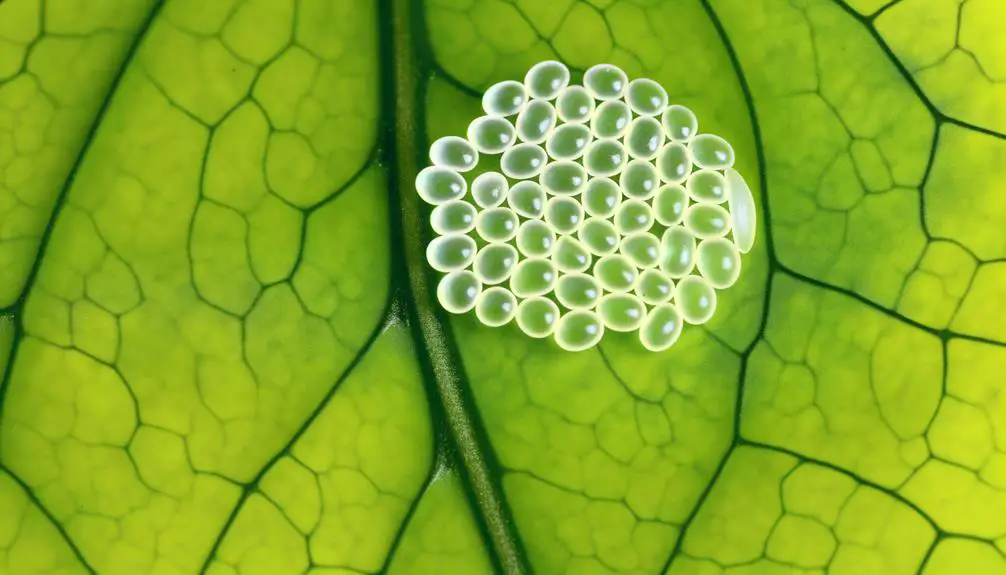
Identifying swallowtail butterfly eggs involves examining specific characteristics such as size, shape, and coloration.
Typically, these eggs are small, spherical, and exhibit a range of colors from pale yellow to vibrant green, depending on the species.
Accurate identification requires careful observation of these features to differentiate swallowtail eggs from those of other butterfly species. Spotting swallowtail butterfly eggs involves examining their color, shape, and placement on host plants. These eggs are typically small, spherical, and may range in color from pale yellow to greenish, depending on the species. Carefully noting these details can help distinguish them from the eggs of other butterflies that share the same habitat.
Size and Shape
Swallowtail butterfly eggs are typically spherical and measure approximately 1-2 millimeters in diameter, making them quite minute and often challenging to detect with the naked eye. Their small size necessitates careful observation for accurate identification. The eggs exhibit a smooth surface texture, which aids in distinguishing them from other insect eggs that may have ridges or bumps.
For precise identification, consider the following characteristics:
- Shape: Mainly spherical, ensuring a uniform appearance.
- Size: Diameter ranges from 1 to 2 millimeters, which is relatively consistent.
- Texture: Smooth outer surface, lacking intricate patterns.
- Placement: Typically laid singly on the host plant leaves.
Understanding these characteristics allows for accurate identification, essential for studying the development and lifecycle of Swallowtail butterflies.
Egg Coloration
The coloration of Swallowtail butterfly eggs is a crucial identifier, often ranging from pale yellow to green, depending on the species and developmental stage.
Generally, newly laid eggs exhibit a pale yellow hue, gradually evolving to green as they approach hatching. This color transformation is attributed to the developing larva and its changing nutritional needs.
For example, the Eastern Black Swallowtail (Papilio polyxenes) lays eggs that are initially creamy yellow before turning green. Conversely, the Giant Swallowtail (Papilio cresphontes) eggs may start greenish-yellow and shift towards a more distinct green.
Such color variations not only aid in species identification but also serve as subtle camouflage against predators, aligning with the butterflies' lifecycle and survival strategies.
Observing in the Wild
When observing swallowtail butterfly eggs in the wild, it is essential to focus on specific host plants such as parsley, fennel, and milkweed where these eggs are typically deposited. These plants provide the necessary nutrients for the larvae upon hatching.
To effectively locate the eggs, consider the following steps:
- Timing: Look during the late spring and summer months when butterflies are most active.
- Plant Inspection: Examine the undersides of leaves and tender stems where eggs are often laid.
- Egg Characteristics: Identify small, spherical eggs, usually 1-2 mm in diameter.
- Habitat: Search in sunlit areas as swallowtails prefer warm environments for laying eggs.
Conclusion
To summarize, swallowtail butterfly eggs exhibit remarkable diversity in size, color, shape, and placement, reflecting their complex life cycle and adaptive strategies.
Significantly, these eggs can range from 1 to 2 millimeters in diameter, a minute yet significant detail for entomological studies.
Understanding these characteristics aids in identification and conservation efforts.
Observations in natural habitats further highlight the intricate beauty and ecological importance of swallowtail butterflies, underscoring the need for continued research and environmental stewardship.






